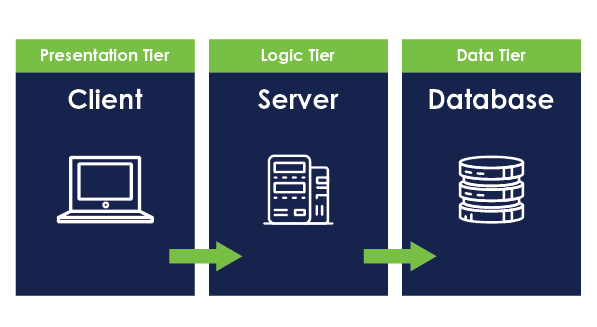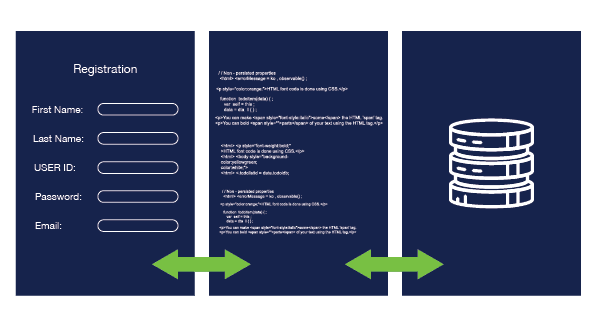Large language models (LLMs) like ChatGPT and GitHub Copilot are rapidly…
When designing a custom software solution, one of the most important considerations developers must take into account is the overall architecture of the system. How a system interacts with all its components determines its effectiveness, and the three-tier architecture approach excels at providing a scalable, efficient solution. This blog post will outline the basic structure of the three-tier architecture system, its advantages, and Zirous’ implementation of this software solution.
Structure
As the name suggests, the three-tier architecture separates system functionality into three distinct tiers, or layers, that exist independently of each other: the Presentation Tier, the Application Tier (or “Logic Tier”), and the Data Tier. The below diagram illustrates the basic structure and communication between each of the three tiers.

In the Presentation Tier, users directly interact with the application. This tier is commonly implemented as a web (browser-accessed) or native (mobile/desktop-accessed) application and developed using frontend frameworks such as Angular, Flutter, or React. When users navigate to a website or open a mobile app, they are interacting with the presentation tier of the application. This tier is only able to communicate with the application tier in the architecture and is restricted from direct interaction with the data tier. Its responsibilities include: relaying commands for the application tier to process, receiving responses from the application tier to read, and presenting information to users.
The Application Tier is where commands input by the user on the presentation tier are interpreted. Common technologies utilized in this tier include backend languages such as Java that implement business logic based on the needs of the business. This tier functions as the brain of the system and creates a managed and secure method of contact between the presentation and data tiers. When a user performs an action such as submitting a form on a web application, the application tier analyzes the information and executes operations to interact with the data tier. These common operations include creating, reading, updating, and deleting information (or CRUD for short).
The Data Tier stores any information sent from the application tier and typically consists of a relational database model. Information is also retrieved from this tier by the application tier to eventually present to the user. There are a variety of systems available to choose for this tier including Oracle, MySQL, PostgreSQL, and many more.
A simple example of these three tiers interacting is displayed in the mock user registration process shown below. First, the user navigates to the registration page via the presentation tier and enters their account information. Once they click ‘Register’ and submit this information, the data is sent to the application tier where it is processed and inserted into the data tier using some form of business logic. Finally, the application communicates to the user via the presentation tier that their submission succeeded or failed.

Registration Request Handler: Searches the Database to find any users with the same email address If a user is found: Return a failure message stating that “A user with that email already exists”
Otherwise: Encrypt the new user’s password Send the user’s information to the Data tier Return a success message stating that “Registration was successful”
Advantages
The main advantage of three-tier architecture is the independent nature of each one of the tiers. Since each tier isn’t entirely dependent on one another, they are able to be upgraded, optimized, or modified with minimal impact on each other. This independence also allows for faster development times as each of the tiers can be developed simultaneously. A common use case would occur when upgrading frameworks as new versions are released. If I wanted to upgrade the framework of the presentation tier from Angular version 10 to Angular version 11, I would be able to do so without any resulting issues to the application or data tiers.
Another major advantage as a result of this architecture is an increased level of security for the application. Since the presentation tier cannot directly communicate with the data tier, malicious attacks can be thwarted by adding safeguards in the application tier. In other architecture systems, such as the two-tier architecture approach, the application tier is non-existent and users are able to interact directly from the presentation tier to the data tier. This can lead to threats such as SQL injection attacks where malicious users modify API requests to gain access to restricted information.
How Zirous Can Help
In the current technology landscape, having a reliable and modern web application is crucial. Zirous provides experience and expertise in custom development revolving around the three-tier architecture system. For more information and to find out if Zirous is the right partner for you, please contact us!




This Post Has 0 Comments